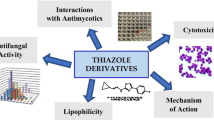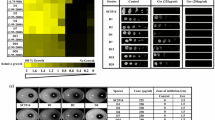Abstract
Natural isopropyl cresols have been reported to have antifungal activity. This work is an attempt to examine thymol and carvacrol against 111 fluconazole-sensitive and -resistant Candida isolates. Insight into the mechanism of action was elucidated by flow cytometric analysis, confocal imaging and ergosterol biosynthesis studies. The susceptibility tests for the test compounds were carried out in terms of minimum inhibitory concentrations (MICs), disc diffusion assays and time–kill curves against all Candida isolates by employing standard protocols. Propidium iodide (PI) cell sorting has been investigated by flow cytometric analysis and confocal imaging. Haemolytic activity on human erythrocytes was studied to exclude the possibility of further associated cytotoxicity. Both compounds were found to be effective to varying extents against all isolates, including the resistant strains. In contrast to the fungistatic nature of fluconazole, our compounds were found to exhibit fungicidal nature. Significant impairment of ergosterol biosynthesis was pronouncedly induced by the test entities. Negligible cytoxicity was observed for the same compounds. Furthermore, it was observed that the positional difference of the hydroxyl group in carvacrol slightly changes its antifungal activity. Carvacrol and thymol show strong fungicidal effect against all of the Candida isolates. The mechanisms of action of these natural isopropyl cresols appear to originate from the inhibition of ergosterol biosynthesis and the disruption of membrane integrity.








Similar content being viewed by others
References
Pina-Vaz C, Gonçalves Rodrigues A, Pinto E, Costa-de-Oliveira S, Tavares C, Salgueiro L, Cavaleiro C, Gonçalves MJ, Martinez-de-Oliveira J (2004) Antifungal activity of Thymus oils and their major compounds. J Eur Acad Dermatol Venereol 18:73–78
Braga PC, Alfieri M, Culici M, Dal Sasso M (2007) Inhibitory activity of thymol against the formation and viability of Candida albicans hyphae. Mycoses 50:502–506
Chami N, Bennis S, Chami F, Aboussekhra A, Remmal A (2005) Study of anticandidal activity of carvacrol and eugenol in vitro and in vivo. Oral Microbiol Immunol 20:106–111
Guo N, Liu J, Wu X, Bi X, Meng R, Wang X, Xiang H, Deng X, Yu L (2009) Antifungal activity of thymol against clinical isolates of fluconazole-sensitive and -resistant Candida albicans. J Med Microbiol 58(8):1074–1079
Sánchez ME, Turina AV, García DA, Nolan MV, Perillo MA (2004) Surface activity of thymol: implications for an eventual pharmacological activity. Colloids Surf B Biointerfaces 34:77–86
Shapiro S, Guggenheim B (1995) The action of thymol on oral bacteria. Oral Microbiol Immunol 10:241–246
Lambert RJ, Skandamis PN, Coote PJ, Nychas GJ (2001) A study of the minimum inhibitory concentration and mode of action of oregano essential oil, thymol and carvacrol. J Appl Microbiol 91(3):453–462
Pinto E, Pina-Vaz C, Salgueiro L, Gonçalves MJ, Costa-de-Oliveira S, Cavaleiro C, Palmeira A, Rodrigues A, Martinez-de-Oliveira J (2006) Antifungal activity of the essential oil of Thymus pulegioides on Candida, Aspergillus and dermatophyte species. J Med Microbiol 55:1367–1373
Nguyen MH, Peacock JE Jr, Morris AJ, Tanner DC, Nguyen ML, Snydman DR, Wagener MM, Rinaldi MG, Yu VL (1996) The changing face of candidemia: emergence of non-Candida albicans species and antifungal resistance. Am J Med 100:617–623
Vanden Bossche H, Dromer F, Improvisi I, Lozano-Chiu M, Rex JH, Sanglard D (1998) Antifungal drug resistance in pathogenic fungi. Med Mycol 36(Suppl 1):119–128
Arias A, Arévalo MP, Andreu A, Rodríguez C, Sierra A (1996) Candida glabrata: in vitro susceptibility of 84 isolates to eight antifungal agents. Chemotherapy 42:107–111
Rex JH, Rinaldi MG, Pfaller MA (1995) Resistance of Candida species to fluconazole. Antimicrob Agents Chemother 39:1–8
Venkateswarlu K, Denning DW, Kelly SL (1997) Inhibition and interaction of cytochrome P450 of Candida krusei with azole antifungal drugs. J Med Vet Mycol 35:19–25
National Committee for Clinical Laboratory Standards (NCCLS) (2002) Reference method for broth dilution antifungal susceptibility testing of yeasts; approved standard M27–A2. NCCLS, Wayne, PA, p. 30
Pina-Vaz C, Sansonetty F, Rodrigues AG, Costa-Oliveira S, Tavares C, Martinez-de-Oliveira J (2001) Cytometric approach for a rapid evaluation of susceptibility of Candida strains to antifungals. Clin Microbiol Infect 7:609–618
Arthington-Skaggs BA, Jradi H, Desai T, Morrison CJ (1999) Quantitation of ergosterol content: novel method for determination of fluconazole susceptibility of Candida albicans. J Clin Microbiol 37:3332–3337
Ahmad A, Khan A, Manzoor N, Khan LA (2010) Evolution of ergosterol biosynthesis inhibitors as fungicidal against Candida. Microb Pathog 48:35–41
Cruz MC, Goldstein AL, Blankenship JR, Del Poeta M, Davis D, Cardenas ME, Perfect JR, McCusker JH, Heitman J (2002) Calcineurin is essential for survival during membrane stress in Candida albicans. EMBO J 21:546–559
Khan A, Ahmad A, Manzoor N, Khan LA (2010) Antifungal activities of Ocimum sanctum essential oil and its lead molecules. Nat Prod Commun 5(2):345–349
Khan A, Ahmad A, Xess I, Khan AL, Manzoor N (2010) Anticandidal effect of Ocimum sanctum essential oil and its synergy with fluconazole and ketoconazole. Phytomedicine (in press). doi:10.1016/j.phymed.2010.02.012
Sayes CM, Reed KL, Warheit DB (2007) Assessing toxicity of fine and nanoparticles: comparing in vitro measurements to in vivo pulmonary toxicity profiles. Toxicol Sci 97(1):163–180
Shimokawa O, Nakayama H (2000) Estimation of minimum sterol 14α-demethylation-inhibitory concentration of azoles in Candida yeasts using acetate-mediated growth inhibition: potential utility in susceptibility testing. J Clin Microbiol 38(8):2893–2896
Shimokawa O, Kato Y, Nakayama H (1986) Accumulation of 14-methyl sterols and defective hyphal growth in Candida albicans. J Med Vet Mycol 24:327–336
Shimokawa O, Kato Y, Kawano K, Nakayama H (1989) Accumulation of 14α-methylergosta-8,24(28)-dien-3β,6α-diol in 14α-demethylation mutants of Candida albicans: genetic evidence for the involvement of 5-desaturase. Biochim Biophys Acta 1003:15–19
Sikkema J, de Bont JA, Poolman B (1995) Mechanisms of membrane toxicity of hydrocarbons. Microbiol Rev 59:201–222
Acknowledgements
The authors wish to thank Dr. Malini R. Capoor, Associate Professor, Department of Microbiology, Vardhman Mahavir Medical College and Safdarjung Hospital, New Delhi, India, for providing some of the clinical isolates of Candida. The authors also wish to thank Ms. Charu Tanwar, Sr. Tech. Assistant AIF, Jawaharlal Nehru University, for her kind assistance. This work was supported by the Indian Council of Medical Research (ICMR), New Delhi (Grant No. 59/24/2008/BMS/TRM [2008-04780]) to Dr. N. Manzoor, Dr. L. A. Khan and I. Xess.
Author information
Authors and Affiliations
Corresponding author
Additional information
A. Ahmad and A. Khan contributed equally to the study.
Rights and permissions
About this article
Cite this article
Ahmad, A., Khan, A., Akhtar, F. et al. Fungicidal activity of thymol and carvacrol by disrupting ergosterol biosynthesis and membrane integrity against Candida . Eur J Clin Microbiol Infect Dis 30, 41–50 (2011). https://doi.org/10.1007/s10096-010-1050-8
Received:
Accepted:
Published:
Issue Date:
DOI: https://doi.org/10.1007/s10096-010-1050-8




